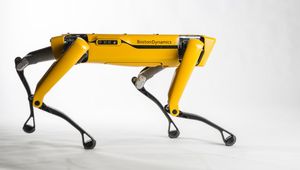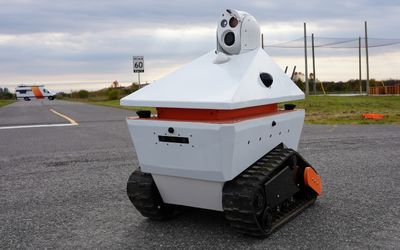AgileX Bunker Pro
An all-terrain tracked-UGV by AgileX features 144Nm torque & 48V/60Ah lithium battery for bigger payload, and Christie & Matilda four-wheel balance suspension with <30°climbing grade and 180mm max obstacle height for greater terrain adaptability.
Technical Specifications
| Dimensions | 1064L x 473W x 845H mm (excluding antenna) |
| Interior Dimension | 800W x 370H x 300L mm |
| Track Width | 150mm |
| Grounding Rod Length | 740mm |
| Weight | 180kg |
| Rated Travelling Load | 120kg |
| Speed | 0~1.5m/s |
| Communication | CAN / RS233 |
| The right rocker controls the movement of the vehicle Remote control | |
| 2.4G/100m without obstacles | |
| Operating Temp | -20°C~60°C |
| IP Rating | IP67 |
| Rated Torque | 144Nm |
| Shock Absorber | 6 independent absorbers on each side |
| Suspension | Christie suspension + Matilda four-wheel balance suspension |
| Max Obstacle Height | 180mm |
| Climbing Grade | 30° without load |
| Min Ground Clearance | 120mm |
| Min Turning Radius | 0m (In-Place/In-situ Rotation) |
| Motors | 2 x 48V DC/1500W brushless servo motor |
| Wheel Encoder | 2500ppr photoelectric incremental encoder |
| Reduction ratio | 1:7.5 |
| Battery | 48V 60Ah Lithium battery |
| Battery Duration | 3h |
| Charge Time | 4.5h |
| Rated Power | 1500W dual-motor drive system |
Overview
Remotely controlled Unmanned Ground Vehicles (UGVs) can function on the ground—ensuring a safe distance for operators to avoid potential danger. They have an overwhelming benefit in applications, which are far too dangerous, rescue, detonation, and exploration, to name a few. Although, missions such as these may need more equipment, thus requiring a bigger payload. Likewise, locomotion through track suits best for rugged terrain, only that they are slower and less efficient, more mechanically complex, and causes more vibration.
The drive-by-wire BUNKER PRO is a tracked chassis vehicle boasting functions for all-around industry applications. Despite its simple operation, it can work in large development spaces for various field applications requiring heavier payloads such as exploration and inspection, special shooting, special transportation, and surveying and mapping. It features an independent suspension system with heavy-duty shock absorption, which displays strong climbing power and the ability to climb stairs.
Design
Excluding the antenna, BUNKER PRO spans 1064L x 473W x 845H mm although the interior dimension measures 800W x 370H x 300L mm. This 180-kg vehicle can carry a rated traveling load of 120 kg with its 150mm track width and grounding rod length of 740mm. It has an IP67 rating, denoting its capability to wade through deep water.
A 2.4G remote control is possible with BUNKERPRO’s Controller Area Network (CAN) over a maximum obstacle-free distance of 100m. The 48V/60Ah Lithium battery gives BUNKERPRO enough power to travel for 3 hours at 1.5m/s max speed without load. The battery has an approximate charging time of 4.5 hours.
Hardware
BUNKER PRO has a rated torque of 144N. It features two 48V DC of 1500W brushless servo motors aside from a 2500ppr photoelectric incremental encoder with a reduction ratio of 1:75. The combined Christie suspension and Matilda 4-wheel balance suspension highlight six independent shock absorbers. This anti-collision design gives stability to the platform, not to mention its adaptability to rough terrain.
The vehicle has a forward tilt track design, allowing it to climb slopes and steps. The climbing grade is 30° without load at a maximum 180mm obstacle height and 120mm minimum ground clearance. It rotates in place (in-situ rotation) at a minimum turning radius of 0mm.
Expansion
Integrating third-party sensors and IMU provides customization for operating BUNKER PRO in advanced operations. The aluminum T-slot rails on top is a standardized mounting solution, which is convenient for mounting external equipment, sensors, and one preconfigured R&D navigation kit.
It has reserve standard profile holes, supporting quick construction of the top loads for industrial control, IMU, routing, camera, and sensing. It also supports a customized design for an aluminum sensor bracket.
BUNKER PRO can support access to more advanced automatic driving systems, like Python, GAZEBO Simulation, and ROS1. It interfaces with external devices through CAN, while secondary developments are possible with the C++ and ROS packages inclusion.
Packages
The fully integrated AgileX R&D solution, designed for robotics research and development, has a full suite of sensors supporting navigation, indoor SLAM, and vision-based application. It also features an Nvidia Jetson Nano computer with Linux Ubuntu 18.04 & ROS Melodic pre-installed software. Other devices include an Intel RealSense depth camera, WiFi module, LCD, and EAI G4 LiDAR.
The R&D Pro package is similar to the standard kit, except for its Nvidia Xavier computer and not to mention the Velodyne Puck LiDAR.
A hardware-software solution enabling autonomous navigation is the AgileX Autopilot Kit, which also provides path planning and avoids obstacles without needing preloaded maps. It comes with various sensors, devices, and computers, including high-precision LiDAR, Pixhawk 4 controller, binocular and depth cameras, and RTK GPS antenna.
AgileX AutoKit, based upon the Autoware open-source software, is a full-stack driving development and education kit at a cost-effective price. It gives a powerful autonomous driving sensor, which integrates seamlessly into the robot platform. An 8-core 32GB RAM computer, LCD, Robotsense 16 channel LiDAR, and a USB-to-CAN module are some of the sensors, devices, and computers that come with the AutoWare Kit.
Software
The open-source Robot Operating System (ROS) is a middleware suite for robot software development. It is not an OS but a software framework collection that provides various functions for a heterogeneous cluster. The cluster includes low-level device control, hardware abstraction, package management, and others.
The Controller Area Network (CAN bus) allows communication between microcontrollers and devices without a host computer. While it is initially built for multiplex electrical wiring in automobiles for saving copper, this message-based protocol is also applicable in a variety of contexts. AgileX CAN bus protocol allows users to communicate over CAN.









